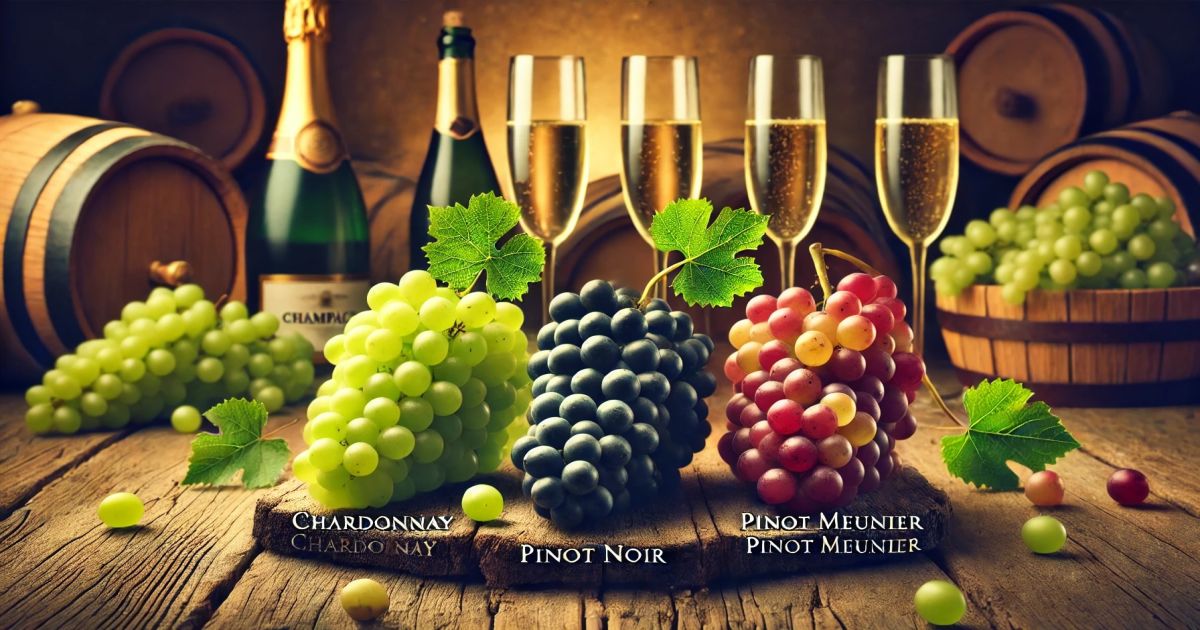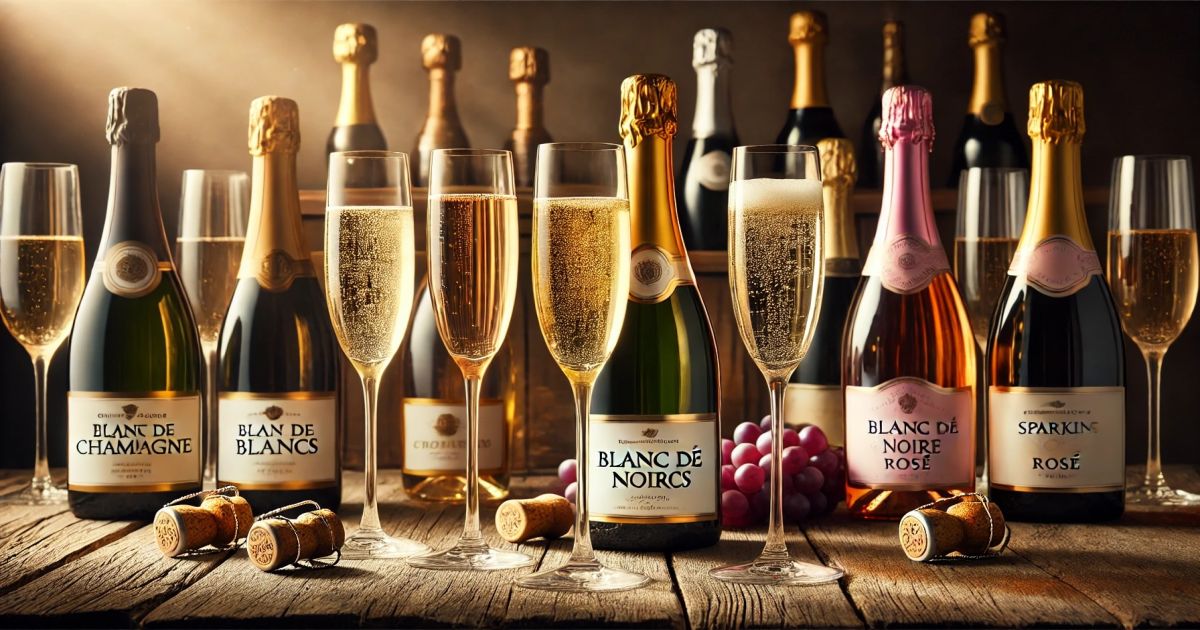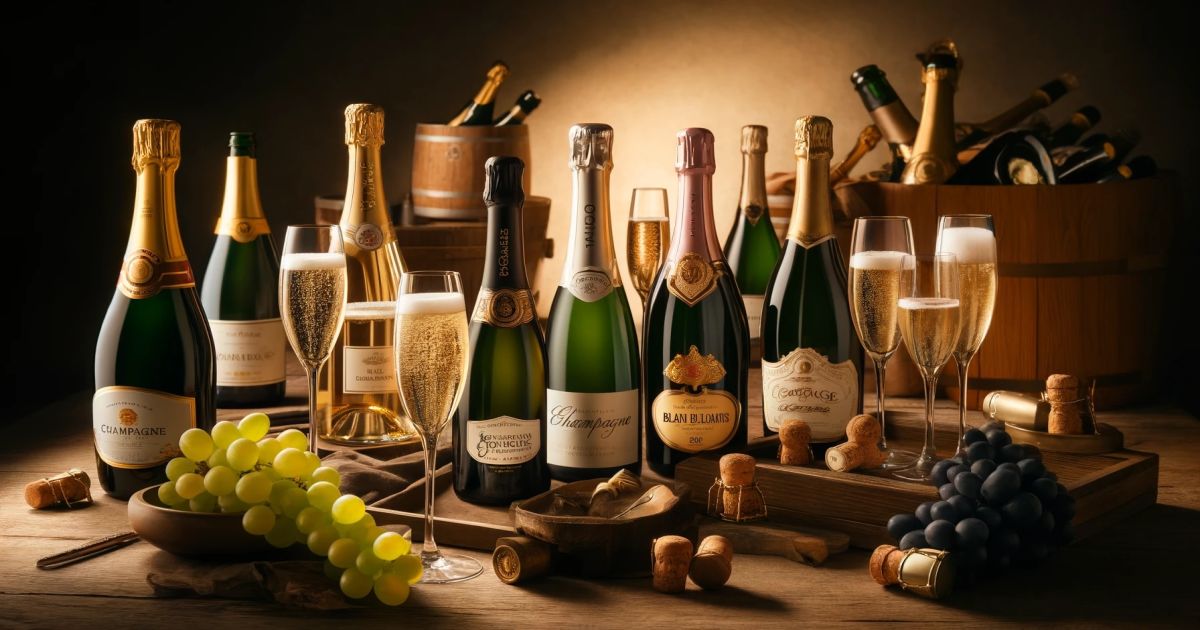The Language of Champagne: A Guide to Understanding the World’s Most Celebrated Sparkling Wine
Discover the unique language of Champagne, from terminology and tasting notes to winemaking terms and classifications. Elevate your Champagne knowledge with this guide.
Champagne is more than just a sparkling wine; it’s a symbol of celebration, luxury, and tradition. With a few key terms like 'Brut' and 'Blanc de Blancs' and some insider tips on things like dosage and terroir, you can enjoy each sip on a whole new level. Discover the lingo of Champagne and make every toast a little more special!
Key Takeaways:
- Classic non-vintage Champagnes like Moët & Chandon Brut Imperial and Veuve Clicquot Yellow Label are perfect for celebrations, offering balanced flavors and easy drinkability.
- Blanc de Blancs Champagnes, made exclusively from Chardonnay grapes, are known for their crisp, elegant profiles and pair well with seafood; options include Ruinart Blanc de Blancs and Billecart-Salmon Blanc de Blancs Grand Cru.
- Blanc de Noirs Champagnes, made from Pinot Noir or Pinot Meunier, offer fuller-bodied, fruit-forward flavors ideal for pairing with rich dishes; try Bollinger Special Cuvée or Egly-Ouriet Brut Tradition Grand Cru.
- Rosé Champagnes like Billecart-Salmon Brut Rosé and Laurent-Perrier Cuvée Rosé add a festive, fruity touch, perfect for special occasions or pairing with a range of foods.
- For luxury choices, vintage and prestige cuvées such as Dom Pérignon and Cristal by Louis Roederer offer complex flavors and depth, making them ideal for significant celebrations.
- For affordable alternatives, Cava, Crémant, and Prosecco provide quality sparkling wine options at a fraction of the price of Champagne.
In this guide, we’ll explore the key terms, classifications, and tasting notes associated with Champagne, helping you become a more informed connoisseur.
The Basics: What Makes Champagne Unique?
Champagne, produced exclusively in the Champagne region of France, is unique among sparkling wines due to its strict regulations and specific production methods. Only sparkling wines from this region, made using traditional techniques and authorized grape varieties, can bear the name “Champagne.” The region’s cool climate, chalky soil, and careful adherence to tradition give Champagne its distinctive character.
Key Grape Varieties in Champagne
Champagne primarily uses three grape varieties, each contributing unique qualities to the wine:
- Chardonnay: Known for its elegance and acidity, Chardonnay is often used in Champagne to bring freshness and crispness. Wines made exclusively from Chardonnay are labeled "Blanc de Blancs."
- Pinot Noir: This grape adds structure, depth, and richness to Champagne. It contributes red fruit flavors and is essential in creating complex, full-bodied Champagnes.
- Pinot Meunier: Pinot Meunier is appreciated for its fruity, floral notes and helps soften the edges of more austere Champagnes. It’s commonly blended with Chardonnay and Pinot Noir for a balanced flavor.
Understanding the Champagne Production Process
The production process of Champagne is called the méthode champenoise or traditional method. This involves a series of meticulous steps that give Champagne its famous bubbles and complex flavors:
- Primary Fermentation: Grapes are fermented to produce a still wine base.
- Blending (Assemblage): Winemakers blend different base wines, sometimes from multiple years, to create a consistent flavor profile.
- Second Fermentation: The blended wine is bottled with a small amount of sugar and yeast, creating a second fermentation that produces bubbles.
- Aging on Lees: Champagne is aged with dead yeast cells (lees), which add rich, toasty flavors.
- Riddling and Disgorging: Bottles are slowly rotated (riddled) to move the sediment to the neck, which is then removed (disgorging) before final corking.
Champagne Sweetness Levels: From Brut Nature to Doux
The sweetness of Champagne is determined by the amount of sugar added after disgorging, a process known as dosage. Here’s a guide to the common levels of sweetness:
- Brut Nature: No sugar added; very dry.
- Extra Brut: Minimal sugar; still very dry.
- Brut: The most popular style, with a balanced dryness.
- Extra Dry: Slightly sweeter than Brut, with a hint of residual sugar.
- Sec (Dry): Noticeably sweet, but still balanced.
- Demi-Sec: Sweet, often enjoyed with dessert.
- Doux: Very sweet, typically reserved for dessert pairings.
Types of Champagne: Blanc de Blancs, Blanc de Noirs, and Rosé
Champagne classifications often refer to the grapes used and the style of the wine:
- Blanc de Blancs: Made entirely from Chardonnay grapes, Blanc de Blancs Champagnes are crisp, fresh, and known for their aging potential.
- Blanc de Noirs: Made exclusively from Pinot Noir and/or Pinot Meunier grapes, these Champagnes are more robust and often have red fruit notes.
- Rosé Champagne: This pink-hued Champagne is created either by blending red and white wines or by allowing limited skin contact during fermentation, resulting in fruity, floral flavors.
Vintage vs. Non-Vintage Champagne
Another key distinction in the language of Champagne is the difference between vintage and non-vintage:
- Vintage Champagne: Made from grapes harvested in a single, exceptional year. Vintage Champagnes are aged for a minimum of three years and often longer, resulting in more complex, nuanced flavors.
- Non-Vintage Champagne: A blend of wines from different years, creating a consistent flavor profile. Non-vintage Champagnes are aged for at least 15 months and are generally fresher and more approachable than vintage Champagnes.
The Importance of Terroir in Champagne
“Terroir” refers to the unique combination of soil, climate, and topography that influences the characteristics of Champagne. The Champagne region has a distinct terroir, with chalky soils that retain moisture and cool temperatures that help maintain acidity. The region is divided into sub-regions, such as Montagne de Reims, Côte des Blancs, and Vallée de la Marne, each producing grapes with distinct flavors and profiles.
Tasting Notes: Describing the Flavors of Champagne
When tasting Champagne, connoisseurs often refer to specific aromas and flavors that highlight its complexity:
- Aromas: Depending on the blend and aging, you might detect notes of green apple, pear, citrus, and floral undertones in young Champagnes. Older Champagnes often reveal aromas of almond, honey, toast, and brioche from extended aging.
- Mouthfeel: Champagne’s bubbles create a lively, effervescent mouthfeel. Quality Champagne has fine, persistent bubbles that contribute to a creamy texture.
- Finish: A well-made Champagne has a long, lingering finish, with flavors that evolve on the palate.
Common Champagne Terms You Should Know
To truly appreciate Champagne, it helps to understand the language used by winemakers and sommeliers:
- Cuvée: A blend of wines; often refers to a specific lot or batch.
- Réserve: Indicates that a portion of the wine comes from a producer's reserve wines, adding complexity.
- Prestige Cuvée: The finest Champagne produced by a house, typically made from the best grapes and aged longer for premium quality.
- Millesime: French for “vintage,” indicating a Champagne made from grapes of a single, exceptional year.
- Recoltant-Manipulant (RM): A grower-producer who makes Champagne from grapes grown on their own estate, often with unique terroir characteristics.
Pairing Champagne with Food
One of the beauties of Champagne is its versatility with food. Here are some classic pairings:
- Brut Champagne: Excellent with appetizers, oysters, sushi, and fried foods, as its acidity and bubbles cut through richness.
- Blanc de Blancs: Pairs well with seafood, light poultry, and creamy cheeses due to its crisp acidity and minerality.
- Blanc de Noirs: Great with heartier dishes like roasted meats, mushrooms, and aged cheeses.
- Rosé Champagne: Complements a variety of foods, from charcuterie and smoked salmon to berry-based desserts.
Why Knowing Champagne Terminology Enhances Your Experience
Understanding Champagne’s unique language allows you to better appreciate its nuances and helps you choose the right bottle for any occasion. By knowing terms like Brut Nature, Blanc de Blancs, and terroir, you’ll have a greater understanding of the flavor profile and style you can expect from each bottle.
Best Champagne
1. Classic Non-Vintage Champagnes
These are approachable and perfect for any celebration or casual enjoyment.
- Moët & Chandon Brut Imperial: A crowd-pleasing, well-balanced Champagne with flavors of apple, citrus, and subtle brioche. Ideal for any occasion.
- Veuve Clicquot Yellow Label Brut: Known for its richness and notes of ripe fruit and toasty brioche, Veuve Clicquot is a great choice for those looking for a classic, full-bodied Champagne.
- Taittinger Brut Réserve: Elegant and fresh, with a delicate mousse and flavors of citrus and green apple. Pairs beautifully with light appetizers and seafood.
2. Blanc de Blancs Champagnes
These are made entirely from Chardonnay grapes, offering a crisp, elegant profile.
- Ruinart Blanc de Blancs: Known for its finesse, with floral and citrus notes, this Champagne has a creamy texture and is perfect for seafood dishes.
- Billecart-Salmon Blanc de Blancs Grand Cru: Refined with notes of pear, citrus, and almond, this is a sophisticated choice for special occasions.
- Pierre Moncuit Blanc de Blancs Grand Cru: A wonderful grower Champagne with a mineral-driven profile, offering flavors of green apple and lemon zest.
3. Blanc de Noirs Champagnes
Made exclusively from Pinot Noir and/or Pinot Meunier, these Champagnes are fuller-bodied and often have red fruit notes.
- Bollinger Special Cuvée: Rich and powerful with flavors of red apple, cherry, and a hint of toasted brioche. Pairs beautifully with roasted meats and hearty dishes.
- Egly-Ouriet Brut Tradition Grand Cru: A bold grower Champagne with a robust, complex flavor profile featuring berries, hazelnuts, and a touch of spice.
- Aubry Brut Rosé: Technically a Blanc de Noirs-style rosé, it offers red fruit notes with a touch of minerality, making it versatile for pairing.
4. Rosé Champagnes
These pink-hued Champagnes are great for festive occasions and pair well with a range of foods.
- Billecart-Salmon Brut Rosé: Elegant and refreshing, with flavors of strawberry and raspberry. Known for its balance and is ideal for charcuterie or desserts.
- Laurent-Perrier Cuvée Rosé: A popular rosé with rich flavors of red berries and a vibrant color, making it a great choice for celebrations.
- Ruinart Rosé: This refined rosé Champagne has flavors of cherry and pink grapefruit, with a hint of floral notes. It’s perfect for romantic occasions.
5. Vintage and Prestige Cuvées
For a truly special occasion, these are higher-end Champagnes with complex flavors and longer aging potential.
- Dom Pérignon Vintage: Known for its depth and complexity, with notes of ripe fruit, spices, and toasted almonds. A prestigious choice for celebrating major milestones.
- Cristal by Louis Roederer: With flavors of apricot, citrus, and brioche, this prestigious Champagne is elegant and balanced, perfect for those looking for a truly luxurious bottle.
- Pol Roger Sir Winston Churchill: Full-bodied with rich notes of hazelnut, pear, and honey, it’s a wonderful choice for those who enjoy complex and mature Champagnes.
6. Affordable Alternatives (Non-Champagne Sparkling Wines)
If you want something budget-friendly, consider these alternatives that mimic the taste of Champagne:
- Cava – Freixenet Cordon Negro Brut: A crisp Spanish sparkling wine with flavors of apple and pear. Great for casual celebrations.
- Crémant de Bourgogne – Louis Bouillot Perle d’Aurore Brut Rosé: Made using the traditional method, this Crémant from Burgundy offers delicate red fruit notes similar to Champagne rosé.
- Prosecco – La Marca Prosecco: A light, slightly fruity Italian sparkling wine. Though not made in Champagne, it’s perfect for brunch or casual gatherings.
Tips for Serving Champagne
- Temperature: Serve Champagne well-chilled, around 45 °F to 50 °F (7 °C to 10 °C).
- Glassware: Champagne flutes or tulip glasses help preserve bubbles and concentrate aromas.
- Opening the Bottle: Gently twist the bottle (not the cork) and release the cork with control to preserve the bubbles.
A Toast to Champagne Knowledge
The language of Champagne is rich, nuanced, and steeped in tradition. Whether you’re toasting a special occasion or simply enjoying a glass, understanding Champagne’s unique terms and classifications enhances the experience. Each sip becomes more than just sparkling wine—it’s an expression of French heritage, a tribute to terroir, and a celebration of craftsmanship.
So next time you pop a bottle, let the language of Champagne guide you. Cheers to deeper appreciation and memorable moments with every bubble!




























